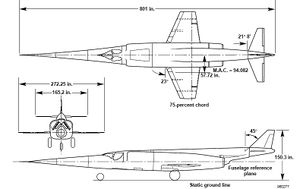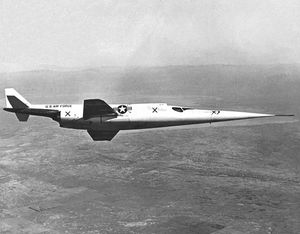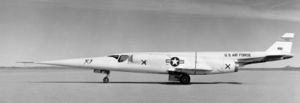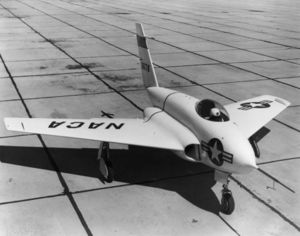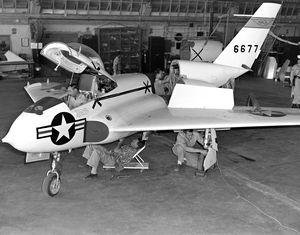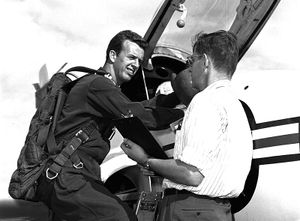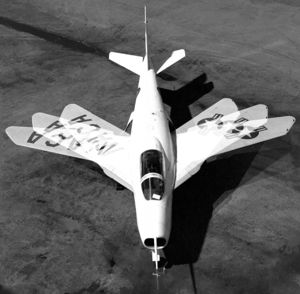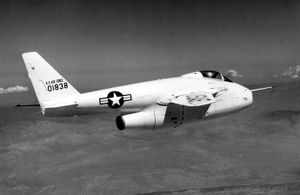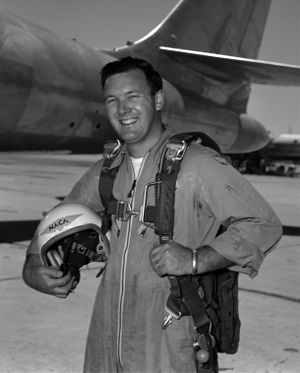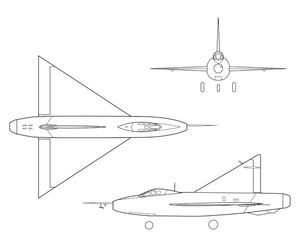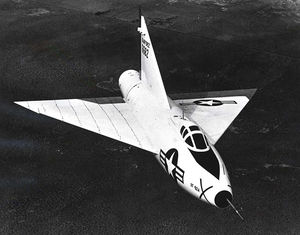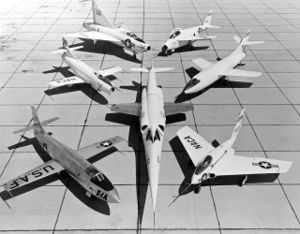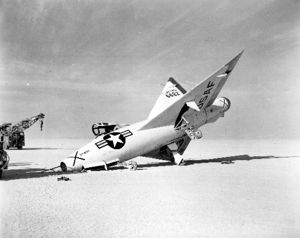First-Hand:Research Airplanes Without Rockets - Chapter 10 of the Experimental Research Airplanes and the Sound Barrier
By David L. Boslaugh, CAPT USN, Retired
The Douglas X-3, A Hoped-for Mach 2 Turbojet
Inception
There were some research airplanes at the High Speed Flight Station that were not rocket propelled, but did contribute significantly to high speed flight research, they were designated X-3, X-4, X-5 and XF-92A. Before reporting for duty at the HSFS, I visited the station in September 1956, and they showed me around. In one of the hangars there was an airplane so sharp nosed, long, slender, and streamlined that it looked like it was going a thousand miles an hour when it was sitting still. Its flight testing days were over, having made its last flight on 23 May 1956, and it was soon to be shipped off to the Air Force Museum. It was the Douglas X-3 “Stiletto”, sponsored by the Air Force.
As early as 1943, the Army Air Force and NACA had been thinking of a research aircraft that could attain supersonic speed for extended periods, in recognition that rocket powered planes could sustain supersonic flight for only a couple of minutes before fuel exhaustion. Power sources such as air breathing ram jets were being considered, and supersonic flight endurance of up to 30 minutes was hoped for. On 30 December 1943, the AAF tasked Douglas Aircraft of Santa Monica, California, to do design and tradeoff studies of various airplane configurations that could fulfill the desired performance. After one and a half years of studies, the Air Force, in June 1945, issued a contract for a turbojet powered craft that could cruise at Mach 2 for 30 minutes. The contract specified that to achieve the required low drag, the plane would use very short, thin trapezoid shaped wings. Specifications also required that the plane should not require a mother plane, but be able to take off an land under its own power . Also, it should not need thrust augmenting boosters for takeoff. [52, p.64] [19, p.63]
Design and Construction of the X-3
For maximum drag reduction. the X-3 fuselage was to be long, thin, and, pointed; and the wings were to be unusually short and thin. They would have only a 4.5% thickness to chord ratio, and as had the X-1 wings, their upper and lower surfaces would be milled from solid aluminum blanks. By July 1949, weight tabulations revealed that the X-3 structure was going to be unacceptably heavy, and as a weight reduction measure Douglas recommended that by using 600 pounds of a very strong, but light weight, titanium alloy in certain parts of the structure, weight could be reduced by over 400 pounds. The rest of the structure except for the all-moving horizontal stabilizer (stabilator) would be aluminum. Because the stabilator would be close to the superheated engine exhaust, it would have a steel frame covered with titanium skin. This would be the first substantial use of titanium in an airplane structure. [39, pp.48-49] [69] [47]
Original design called for the X-3 nose to be separable escape pod, but evolved to a downward firing ejection seat for pilot escape. For normal pilot entrance and egress, the ejection seat would be electrically lowered on rails, the pilot would sit in the seat and be hoisted up into the pressurized cockpit. The canopy was an integral part of the fuselage, and could not be removed, so for ground escape, one of the large cockpit side windows could be detached. The long, thin nose housed NACA instrumentation, with a smaller instrument bay in the aft fuselage. The 1,200 pounds of instrumentation would include 150 thermocouples and 150 strain gages embedded in the skin as well as 850 pressure orifice holes in the skin. There would also be the usual flight parameter, control deflection and pilot control force measurements. Three fuel tanks would be built into the fuselage; one filling the tail boom, a balancing tank forward in the fuselage, and one under the engines. [69] [39, p.46, 49] [52, p.64]
In parallel with X-3 design, Westinghouse Electric Company was developing their new J46-WE-1 turbojet engine, having 6,600 pounds of thrust with afterburner, and the development schedule well matched X-3 construction schedule. The plane was thus designed around two of these advanced engines, that would be able to propel the X-3 to over Mach 2. By mid 1949 the J-46 had fallen so far behind schedule that in October the Air Force and Douglas decided to substitute the lower thrust (4,900 pounds) Westinghouse J34-WE-17 turbojet as an interim measure until the J-46 was available. On 30 September 1951, X-3 construction was complete, and the plane was moved to the Douglas flight test hangar for static load testing. Static testing disclosed structural problems, and almost a year was spent correcting structure problems, and fixing fuel tank leaks. The plane was delivered by truck to Edwards Air Force Base on 11 September 1952. [39, pp.47- 48] [19, p. 63] [69] [47]
Flight Testing the X-3
Douglas test pilot William B. Bridgeman, who had done initial testing of the D-558 Phase II series, started the X-3 tests on 15 October 1952 with a high speed taxi that included a liftoff across the lake bed for a mile. Five days later he made a 20 minute flight, followed by 24 other flights lasting until December 1953. Bridgeman found the X-3 with its substitute J-34 engines, disappointingly underpowered, and unable to reach Mach 1 in level flight. He was able to reach Mach 1.21 in a slight dive, and later on 28 July 1953 he achieved Mach 1.208 in a thirty degree dive; the highest speed of his testing program. He found it was not an easy airplane too fly. Even to get airborne, he had to get the craft up to 299 mph takeoff speed. [47] [52, p.64] [39, p.48]
The air force accepted the X-3 in December 1953, and assigned LCOL Frank Everest and MAJ Charles Yeager as test pilots. They each made three flights before turning the plane over to the High Speed Flight Station. NACA wanted to gather data on pressure distributions, wing and tail loads, and stability and control. The first flight by an NACA pilot was by Joseph A. Walker on 23 August 1954, and he made nine flights ending on 21 October, gathering static stability, pressure and structural loads data. NACA engineers realized that the plane’s long slender shape and short wings with most of its mass concentrated in the fuselage would make it an ideal candidate to study the phenomenon of roll coupling where a quick roll could cause sudden pitching and yawing motions. Roll coupling had caused the unexpected, violent motions and subsequent tumbling experienced by Chuck Yeager in his wild ride in the X-1A in December 1953. [69] [52, p.65]
NACA engineers had developed equations describing roll coupling and had theories, but needed flight tests to confirm their theories. On 27 October, Walker made a flight in which he was to make a series of aileron rolls, with rudder fixed at neutral, to induce roll coupling. His first roll was at Mach 0.92, and resulted in a sudden yaw and pitch up with loss of control for a number of seconds, but he then brought the craft back under control. No harm had been done, so Walker next put the X-3 into a shallow dive to Mach 1.05, and executed his next roll. This time, thanks to the higher speed and stability characteristics changed by entering into the sonic region, the pitching and yawing transients were much more violent, causing stress loads up to seven gs. Walker terminated the flight and landed to have the craft undergo structural inspection before it could fly again. In the mean time, analysis of his flight recordings showed that the craft’s behavior closely confirmed the engineer’s theories. Walker would go on to make 11 more flights, ending the program on 23 May 1956. Though he had not made many flights, they had been found to be quite productive, especially the findings on roll coupling. [52, p. 65] [15, p.42] [8, pp.34-36] [39, p.49]
The more powerful Westinghouse J46 engine never materialized, and the X-3 was constrained to using the smaller J34 engines for its entire research career. Even though the X-3 was a disappointment due to low engine power, and had a fairly short operational life, it did make contributions to aeronautical knowledge. Perhaps the most important contribution was verifying roll coupling theory. Also, the pioneering procedures Douglas developed in machining, forming, and cutting titanium was useful to the aircraft industry in general. The plane’s short thin trapezoidal wing was also new to the industry, and the knowledge gained in designing and flight testing the wing was directly applicable to Lockheed Aircraft Corporation designers in the use of a very similar wing in the Lockheed F-104 fighter. [69] [47] [52, p.65]
One of our mechanic friends told us of the trials and tribulations of the X-3s tires. Takeoff speeds of almost 300 mph often caused the plane’s tires to fly apart due to the high centrifugal force. He told us how they took the tires down to a shop in Los Angeles where they were machined perfectly round and very carefully balanced. Then they would install the tires on the X-3 and hope. Sometimes the tires survived a takeoff roll, but often the flight had to be aborted when the tires disintegrated. Each time, NACA and Douglas returned the tire remains to the tire manufacturer who made improvements in tire fabrication that gradually make the tires more resistant to the high speeds, so it can be said that another contribution of the X-3 project was to tire technology. Today, the X-3 can be seen at the Air Force Museum, Dayton, Ohio. [47] [52, p.65]
The Northrop X-4 Semi-tailess Research Airplane
Inception
Two of the High Speed Flight Station’s more productive research airplanes were no longer at the station when I started in October 1956. Both of the diminutive semi-tailless X-4 research airplanes had been trucked off to museums in early 1954. Soon after the end of World War II, researchers were convinced that longitudinal (pitch) stability and control problems with fighter aircraft in transonic flight were caused by the interaction of shock waves generated by the wing and horizontal stabilizer that were adversely interacting on the horizontal stabilizer. They seemed to render the horizontal stabilizer and elevator ineffective, and the question arose; what if the horizontal stabilizer was removed, with pitch stability and control provided by swept back wings? There were already precedents for such a configuration. The Messerschmitt Me 163 semi-tailless rocket interceptor had gone operational in May 1944, and the experimental jet propelled de Havilland Dh 108 “Swallow” had first flown in May 1946 [54, p.163] Both of these craft had a vertical stabilizer/rudder but no horizontal stabilizer, and both were capable of transonic flight. The form of the X-4 would turn out to be be strikingly similar to these two aircraft. Other similar precedents were the series of flying wings developed by Jack Northrop, starting with hs tailless N-1M flying wing that first flew in July 1941. Northrop followed that with an Army Air Force contract for the wartime-developed prototype YB-35A reciprocating engine powered flying wing heavy bomber. Later in 1947, Northrop built the YB-49 jet powered variant of the YB-35A, of which two were built, but never went into production. [39, p.51-52]
By late 1945 the Air Force and NACA also had convincing evidence that a swept wing airplane without a horizontal stabilizer might alleviate transonic compressibility effects and so increase the critical mach number of fighter airplanes. Accordingly, the Air Force agreed to sponsor such a research airplane. There was also the fringe benefit that the absence of a horizontal stabilizer would reduce aerodynamic drag, allowing a higher speed for a given engine thrust. On 11 June 1946, the Air Force awarded a sole source contract to Northrop Aircraft Corp., based on their previous experience with flying wings, to build two semi-tailless research airplanes. They would be designated X-4. [48] The planes were not intended for supersonic flight, but rather would explore the transonic region up to about Mach 0.85. [52, p.65]
Design and Construction of the X-4
It was agreed that the X-4 would be kept as small as possible so that it would be sensitive to fairly minor transonic perturbations, and this allowed use of two small Westinghouse XJ30-WE-9 engines having 1,600 pounds of thrust each. The 40 degree swept wing was made of magnesium, and featured large split flaps that doubled as speed brakes. The speed brakes would come in very handy as a means of rapidly decelerating away from a dangerous compressibility situation, and also as a way to simulate the flying qualities of other research airplanes having low lift-to-drag ratios. Other than the magnesium wings, the rest of the X-4 was of conventional aluminum construction. [52, p.65, 67]
Having no horizontal stabilizer, the plane was fitted with ailerons that also served as elevators, the arrangement being called “elevons.” The split flap dive brakes as well as the elevons were moved by hydraulic cylinders, and the control stick was given pilot feedback feel by centering springs at the bottom. Control cables from the stick actuated the elevon hydraulics by causing lateral stick motion to move the surfaces differentially, and longitudinal control input to move the surfaces up or down in synchronism. [52, p.66] [48] The rudder was initially positioned by an electric servo, but proved too slow in responding, so direct rudder pedal cable connections were eventually used. As a concession to pilot safety, the X-4 was equipped with an ejection seat. [39, p.57]
During a customer inspection review of the X-4 mockup in November 1946, the NACA representative unhappily noted that there was no space in the plane for the NACA instrumentation package. The issue was resolved by reducing fuel tank volume to the extent that the plane had only enough fuel for 45 minutes flying time. [39, p.52] An unusual design feature allowed the aft end of the fuselage behind the wing to be completely separated for access to the engines and instrumentation bay, and the plane was small enough that most maintenance work could be done without standing on a ladder or stool. [48] The first X-4 was ready for customer acceptance inspection June 1948. [52, p.66]
Flight Testing the X-4
The first X-4 was trucked to Muroc on 15 November 1948, and Northrop test pilot Charles Tucker made its first contract qualifying flight on 16 December. This aircraft was found to be mechanically very unreliable with a continuing string of problems. After ten Northrop test flights, the Air Force and Northrop agreed that its testing would be terminated and it would be used as a source of spare parts for the second X-4; that Tucker first flew on 7 June 1949. He would make 20 flights in X-4-2, completing the Northrop contract qualification program in February 1950. [52, p.66] [48] The plane was then turned over to the High Speed Flight Station who installed the NACA instrumentation suite, taking until August 1950 to complete. The next 14 flights would be by Air Force test pilots: BGEN Albert Boyd, MAJ Charles Yeager, COL Frank Everest, and CAPT J. S. Nash who made pilot checkout and longitudinal stability and control flights in August and September. [39, p.56]
Starting in late September, HSFS pilot John A. Griffith made a series of seven flights evaluating the plane’s longitudinal, lateral, and directional stability, completing on 17 November. This was followed by the last Air Force piloted flight by LCOL Richard Johnson on 6 December. [39, p.56] Then a newly arrived NACA pilot, A. Scott Crossfield took over most of the flight test program. In his book “Always Another Dawn”, Crossfield described his first flight in the X-4. He noted that it handled very well at speeds below the compressibility limit, but as he approached Mach 0.88 the plane broke into a porpoising motion that got worse with increasing speed. He flipped open the speed brakes to back away from the situation. The plane handled so nicely at lower speeds that he was lulled into trying a loop. At the top of the loop he learned that the two XJ-30 engines could be very touchy when their air flow was disturbed, especially at altitudes near 30,000 feet. After making a horrendous noise, both engines flamed out, and he considered himself fortunate in getting one restarted so he could make it back to the lake bed. [7, p.42-43]
As X-4 flight testing progressed, it became clear to NACA test pilots and engineers that the absence of the horizontal stabilizer did not mitigate shock wave effects. At speeds above Mach 0.88 the plane began an uncontrollable pitching oscillation, and as speed increased, the nose wanted to pitch down and oscillations began about all three axes. There was some evidence that blunting wing and control surface trailing edges made them more effective at transonic speeds. So starting in July 1951 HSFS engineers blunted the trailing edges of the split flaps by inserting a wedge of wood between the flaps, and blunted the elevons with wedges of wood fastened to the surfaces. Flight tests showed that the change increased the onset speed of compressibility effects from Mach 0,88 to Mach 0.92. [48] On 22 September 1952, Crossfield brought the X-4 to the highest speed it ever achieved, Mach 0.94. He verified that the blunt trailing edges definitely increased the critical Mach number, but also found at the higher speed the longitudinal oscillations decreased in size but increased in frequency. Furthermore, the yaw and roll instability got worse. The benefits of the blunt trailing edge control effectiveness improvements would eventually be applied to the X-15 hypersonic research airplane that was given thick wedge shaped vertical stabilizers. [39, p.55]
Following these flights, the wedges were removed and a number of flights were made with speed brakes deployed at various settings to simulate the handling qualities of forthcoming research airplanes and high performance fighters. Specifically planes that would have low lift-to-drag ratios with consequent high sink rates on landing. X-4 number 2 was permanently grounded in September 1853 due to unrepairable fuel tank leaks, and both X-4s would be sent off to museums early the following year. The X-4 had survived four years of flight testing without serious incident, but had shown that flying wings and semi tailless aircraft were not viable at transonic and higher speeds. The second X-4 made 102 flights: 20 by Northrop pilots and 82 by Air Force and NACA pilots. Thirteen test pilots had flown the X-4s including 30 flights by Northrop pilot Charles Tucker, 29 by Scotty Crossfield, 14 by NACA pilot Walter Jones, and seven by Chuck Yeager. [39, p.5-56]
Today, flying wings work under perfect control in the transonic and supersonic regions thanks to sensors coupled with high speed digital computers that send instant commands to the control surface actuators. These artificial stability augmentation systems can react to motion disturbances at speeds thousands of time faster than the reaction times of human pilots, and with rapid small control surface deflections can make an unstable airplane feel completely well behaved to its pilot. The number two X-4 now resides at the U. S. Air force Museum at dayton, Ohio, and the hardly flown first X-4 is back at Edwards Air Force Base in the Flight Test Museum.
The Bell X-5 Variable Sweep Research Airplane
Descent from the Messerschmitt Me P.1101 Prototype Fighter
Though its flying days had ended in late 1955, there was a small, ungainly looking plane sitting in a corner of one of our hangars when I started at the station in October 1956. It was parked with its wings fully swept back to 60 degrees to save hangar space, and its claim to fame was that it was the first airplane in history that could vary the sweep of its wings in flight. It had probably been kept at the High Speed Flight Station beyond its research days because its speed and endurance gave it the potential to be used as a chase plane, and indeed it had been used at least once in that role. It had German ancestry.
The German Air Ministry in July 1944 requested proposals for an advanced jet propelled fighter as a follow-on to the Messerschmitt Me 262 twin jet fighter bomber. Its engine was to be one Heinkel-Hirth S 011 gas turbine, and it was to be capable of a level speed of 621 mph at 22,966 feet altitude. It was also required to reach an altitude of almost 46,000 feet and be armed with four 30 mm cannon. After some preliminary design work and wind tunnel testing of various configurations, Messerschmitt decided to finance their own prototype entry, designating it the P.1101. They would save design and construction time by building part of the craft out of existing assemblies, for instance the wings would be from the Me 262, and the main landing gear would be from the Bf 109 piston engine fighter. The wing would be covered with thin plywood, and the horizontal and vertical stabilizers would be all wood. The fuselage would be fabricated out of duraluminum. The plane was to be built at a hidden Messerschmitt factory at the village of Oberammergau in the Bavarian Mountains. The craft was to have a swept wing which would result in low drag at the high speeds specified. However, company engineers were not sure of the wing sweep angle needed to allow high speeds, but yet provide acceptable low speed handling performance needed in an operational fighter. Therefore, they arranged that the wing could be mounted at three different sweep angles: 35, 40, and 45 degrees for flight testing. Sweep angle would be set on the ground, and could not be varied in flight. Once the best angle was determined, all production planes would be built with that configuration. [27]
Flight testing was to begin in June 1945, but advancing American troops discovered the Oberammergau plant on 29 April 1945; with the P.1101 only about 80% complete. American aeronautical experts, including Robert J. Woods of Bell Aircraft Corp., arrived a few days after the troops to evaluate German technical progress at the plant. Woods was so impressed with the advanced nature of the plane that he and Woldemar Voight, the plane’s designer, requested occupation authorities’ permission to complete construction so the plane could be flight tested. Unfortunately, French troops had found the hidden microfilm plans for the craft, and the French Government would not concur with turning over plans for a weapon that would have been used against them. In truth, the plane was intended to even outperform the Me 262 with which the most advanced Allied fighters had hardly been able to cope. The Army Air Force did decide to ship the P.1101 back to Wright Patterson Air Force Base for further evaluation, and the plane sustained considerable damage in transit. [27]
From Messerschmitt to Research Airplane
The Air Force completed their static evaluation of the p.1101, and it sat neglected for almost three years until Bell chief engineer Robert Woods, still fascinated by the airplane, arranged for the Air Force to turn the plane over to Bell Aircraft. Woods could see potential in the design as a lightweight tactical fighter, and in his thinking he would equip the craft with a wing capable of changing its sweep angle in flight, rather than the German plan of fixing the wing with one angle of sweep back. With wings swept back at 60 degrees, the plane would have a low-drag wing that enables higher speeds than a straight wing for a given power setting, but with the disadvantage of a stalling speed that is too high for landing a tactical fighter. On the other hand, a straight wing fosters good low speed handling and landing qualities. Woods reasoned that a fighter that could sweep its wings back or forward in flight would be the best of all worlds [18, p.3] His proposed fighter would be based on the P.1101 but a little larger, and since detailed engineering drawings were not available, he would use the German plane primarily as a template. Bell engineers even went so far as to install a production Allison J-35 turbojet engine in the P.1101 as well as dummy machine guns to demonstrate feasibility. [Johnson]
In the fall of 1948, Bell Aircraft submitted a proposal to the Air Force to provide 24 engineering development model fighter interceptors roughly based on the P.1101, but with variable geometry wings. After detailed engineering review, the Air Material Command (AMC) turned the proposal down, but Woods was not daunted yet. His next tack was a proposal to provide two swing-wing research airplanes, with the hope that if the research airplanes were successful, the Air Force would follow through with a fighter production contract based on the research airplanes. As preparation for his submission, Woods first lobbied NACA officials who became convinced that such a research airplane could have multiple payoffs. Existing swept wing experimental aircraft, such as the D-558-II and the X-4, could provide aeronautical data at only a single sweep angle. A variable swept wing aircraft would be equivalent to a series of such experimental aircraft, as it could change the wing angle to the desired research objectives. [49] It could thus be used to: determine the optimum sweep back angle for a fighter airplane, investigate the tactical advantage of being able to vary sweep angle in flight, and develop the engineering basis for a production wing sweeping mechanism. NACA strongly recommended that the Air Force authorize and fund the proposal that Bell submitted on 1 February 1949, and three days after receipt, Headquarters, USAF directed the Air Material Command to accept the proposal. [18, p.3]
AMC responded with a detailed specification to Bell Aircraft that included the requirement that the planes be initially be fitted with an Allison J-35-A-17 gas turbine non-afterburning engine (having 4,900 pounds thrust), and have the capability to accommodate the more powerful Westinghouse XJ-46-WE-2 engine, when available. This is the same engine originally planned for the X-3 research airplane, but never materialized. The wings were to be capable of locking at sweep angles of 20, 40, and 60 degrees, and the craft was to be capable of a maximum speed between 690 and 716 mph and altitudes up to 50,700 feet. The plane was also to be able to carry 500 pounds of NACA instrumentation. The specification further stated that no later production of the airplanes was contemplated, and that after initial USAF evaluation of the first delivered, they would both be turned over to the High Speed Flight Station for detailed testing. It also called for Bell to fabricate and deliver three specialized wind tunnel models for: stability & control, spin tunnel, & supersonic wind tunnel testing. With Bell Aircraft in agreement with the specification, AMC issued a contract on 26 July 1949 for two research airplanes to be designated X-5-1 and X-5-2. [18, pp.16-22] [1] [39, p.59]
Design and Construction of the X-5
Bell Aircraft already had a template in the P.1101 to guide general design, however the wing sweep mechanism was to be completely new, and was the greatest design challenge. The wing pivot points were to be just outside the fuselage, meaning the whole wing would have to translate fore and aft as the wings changed sweep in order to keep the wing’s center of pressure lined up appropriately with the plane’s center of gravity. This called for a sweep mechanism, moved by electrically powered screw jacks, that could move the wing root forward by 27 inches as the wings swept aft from 20 to 60 degrees. Two sets of screw jacks were called for: one set that swept the wings, and another that moved a cradle on rails that carried the wing root. Disk brakes were built into the pivot points to lock the wings in place, and full sweep through 40 degrees could be done in 20 seconds. Wind tunnel tests had shown that the X-5 could not be safely landed if the wings were swept further back than 40 degrees, so as a safety feature, the pilot was provided a hand crank to move the wings in case of sweep mechanism failure. The pilot could also translate the wings fore and aft through a range of 4.5 inches with the wings locked at the chosen sweep position. The wing sweep mechanism weighed 340 pounds, which the Air Force declared too heavy for a tactical fighter. [18, pp.27-30, p.33] [49]
Though the P.1101 tail surfaces and wing skins were made of wood, the entire X-5 would be of conventional aluminum construction. The 50,700-foot altitude requirement necessitated a pressurized cockpit fitted with a rudimentary ejection seat. In case of ejection, the cockpit canopy would first be blown backward along its rails. Wind tunnel testing of the spin model showed adverse spin characteristics with wings fully swept, so a small ventral anti-spin fin was fitted beneath the tail. Spin tunnel model testing did not show severe enough spin tendency to fit the X-5s with a spin recovery parachute. More about this later. X-5-1 construction was finished on 15 February 1951, after which it was disassembled, packed in crates, and flown to Edwards Air Force Base by C-119 “Flying Boxcar” on 9 June 1951. [39, p.65] [18, p.40]
Flight Testing the X-5
Before the Air Force could start its flight testing program, the contract called for a number of flights by the contractor to prove airworthiness, and Bell test pilot Jean L. “Skip” Ziegler made the first of these on 20 June. On his fifth flight, Ziegler cycled the wing sweep system for the first time moving from 20 to 30 degrees. Working sweep angle back slowly, on his 9th flight on 27 July Ziegler moved the sweep mechanism through its full 20-60 degree range. On 21 August, Brigadier General Albert Boyd, Commander of the Flight Test Center made one flight in X-5-1. He set wings at 60 degrees sweep and brought the plane up to Mach 0.92, then Bell Aircraft testing resumed. [18, pp.31-32, p.43] The Bell flight tests continued through July and August 1951, with Ziegler’s 19th and final contractor flight on 8 October 1951. Maj. Frank Everest then made six Air Force flights in the aircraft during December 1951 and January 1952. After a final flight by Everest on January 8, 1952, the X-5-1 was turned over to the High Speed Flight Station. By this time, the second X-5 had been delivered by a C-119 transport and Ziegler flew an X-5-2 contract qualification flight on 10 December. [49] The Air Force accepted X-5-2 on 18 December and resumed its test program. [18, p.46]
HSFS pilot Joe Walker was assigned as NACA X-5-1 project pilot, and made his first flight on 9 January 1952. His early flights investigated longitudinal and lateral stability and control, both static and dynamic, with the wings set at all three positions. He also tested gust response with the wings at 20 and 60 degrees. In April 1952, HSFS pilots A. Scott Crossfield and Walter P Jones joined the project, with Jones making eight X-5 flights before leaving NACA to fly for Northrop Corporation, and Crossfield would make 10 flights. [49] In his book “Always Another Dawn” Crossfield described his first flight in the X-5 on 3 March 1952 where his mission was to make aggravated stalls to help determine safest flyable low speeds when the wings were set at the maximum 60 degree sweep. He noted that the plane “handled loosely and danced crazily,” and was not a comfortable craft to fly. One of the problems was the location of the engine thrust axis considerably below the plane’s center of gravity that made longitudinal control difficult. In one of his stalls, the plane fell into a spin from which it took 10,000 feet to recover. He noted the plane was a terrible spinner, and recommended that any testing that might result in a spin should never be done at altitudes below 20,000 feet. [7, p.154]
On October 21 1952 Joe Walker accidentally entered a spin at 36,000 feet with wings set at 60 degrees, and he needed 18,000 feet to recover. Then in October 1953 Air Force Major Raymond Popson, who had been assigned to investigate stall behavior in the Air Force’s X-5-2 at 12,000 feet, fell into a spin where he did not have enough altitude to recover. He was killed in the ground impact. It was realized that the X-5 with wings at 60 degrees was almost impossible to bring out of a spin, and it was also realized that wind tunnel spin testing of the X-5 had not shown the true dangers. The principal culprit seemed to be insufficient vertical stabilizer authority with wings swept to 60 degrees. This led to NACA investigation and improvements in spin tunnel testing techniques that could more accurately predict airplane spin behavior. The Air Force, from time-to-time, had been considering a fighter version of the X-5, but revelation of the plane’s extremely bad spinning characteristics caused the service to permanently abandon the idea. [7, p.145] [49] [66]
On April 23, 1954, Walker made his last X-5 flight, and two new NACA pilots, Stanley P. Butchart and John B. "Jack" McKay, were assigned to the program. Their main work was making stability and control test flights from June 1954 into October 1955. By this time, they were both well versed in the plane’s spinning behavior, prompting Butchart to note "You just had to know that and stay away from it." The final NACA X-5 flight was made on October 25, 1955, by a new High-Speed Flight Station pilot, Neil A. Armstrong. It was to be his initial checkout flight in the craft, and his checkout briefer Jack McKay told him that usually it was difficult to get the nose gear to lock up upon gear retraction. He advised nosing over to 1/2 G during retraction to help the gear lock up. Armstrong thinks he probably exceeded the the gear-down limit speed in the process because part of the gear fairing door broke off. Senior station management had already decided that the plane was about at the end of its productive research life, and it was not worth repairing the plane. The X-5 remained in the HSFS hangar until March 1958, but never flew again. In all, the NACA X-5-1 made 122 flights, and was flown by seven different NACA pilots including one flight by John P. Reeder from the Langley Laboratory. [49] [20, p.174]
The X-5 was the world’s first flying variable geometry aircraft, and in spite of the its poor stall and spin characteristics, all of its research goals were met. Flight results verified wind tunnel predictions of drag reduction and and resulting speed performance improvements for swept wing airplanes. Even though it did not validate spin tunnel predictions, it contributed to improvements in spin tunnel testing, and it gave designers valuable information on the optimum wing sweep for fixed swept wing aircraft. The unacceptable stalling and spinning characteristics were found to be due to the basic design of the X-5, in particular insufficient vertical stabilizer area, rather than the 60 degree sweep back. Even though it was a difficult and dangerous airplane to fly, it yielded valuable research results, and it paved the way for a number of tactical variable geometry aircraft. These included: the Rockwell B-1 bomber, General Dynamics F-111 Aardvark fighter, Grumman F-14 Tomcat fighter, British Panavia Tornado fighter, and the Soviet MiG-23 fighter. In these airplanes, thanks to NACA and Air Force experience, the wing sweep mechanism was simplified and lightened by eliminating the need to translate the wing root backward or forward as sweep was changed. This was accomplished by moving the wing pivot points further outside of the fuselage so that wing area forward and aft of the pivots remained the same regardless of degree of sweep. [39, p.67] X-5-1 now resides in the Research and Development Hangar of the National Museum of the U. S. Air Force at Wright Patterson Air Force Base, Dayton Ohio. [66]
The Convair XF-92A Delta Wing
Inception
In 1921, while Dr. Alexander M. Lippisch was working for the Zeppelin Company of Germany he began a lifelong interest in flying wings and semi tailless airplanes. By 1931, he had designed the worlds first flying tailless delta wing aircraft, named Delta I, after which he designed and built four more delta wings between 1931 and 1939. In 1939 the Reich Aviation Ministry assigned Lippisch to the Messerschmitt organization where he was tasked to help design a series of rocket powered fighter aircraft, eventually emerging as the rocket powered delta wing Me 163 Komet interceptor. In 1943 he transferred to the Vienna Aeronautical Institute where he did research on transonic and supersonic flight, and came to the conclusion that the low drag of delta wings would be ideal for supersonic flight. [35, pp.116-117] [64]
Following World War II Lippisch moved to the U.S. under the Operation Paperclip Program and served as a consulted to the Consolidated Vultee Aircraft Corporation, (now Convair). By this time new rocket and turbojet engines were beginning to make supersonic flight realizable, and Convair engineers began the design of a jet and rocket propelled fighter which they presented to the Air force in mid 1946. They proposed it as a Mach 1.5 point defense interceptor. The Air Force responded by issuing a contract for two working prototypes, to be designated XF-92; XF meaning experimental fighter. [35, pp.116-117] The XF-92 would be the first delta winged aircraft in U.S. military inventory, and soon after receiving the initial contract, Convair proposed building a smaller delta winged prototype to gain flying experience to guide design of the fighter. The Air force agreed and issued a contract modification in November 1946. By the time the small pre-prototype was ready for testing in mid 1948, the Air Force had abandoned the concept of a point defense interceptor, and cancelled the main contract; but did authorize completion of the pre-prototype for research use. They designated the research plane plane XF-92A. [57, p.267] [67]
Design and Construction of the XF-92A
The XF-92A was of conventional aluminum construction with the leading edge of the delta wing swept back 60 degrees. Directional stability of a delta wing was an unknown, so Convair gave the craft an unusually large vertical stabilizer and rudder to help insure stability. Roll and elevator control was by “elevons” on the wing trailing edge, and all control surfaces were to be moved by hydraulic servomechanisms. Pilot control feel was provided by centering springs on the control yoke and rudder pedals. The plane was one of the first to have an “irreversible” hydraulic control system, and not much was known about right amount of pilot control feel. Most of the later pilots would say the centering springs were too light, making the plane very sensitive in control. [80, p.159] There was neither an excess of time or money to build the pre-prototype, and to save both, many components from existing airplanes were used. For example, an early version of an Allison J-33 turbojet engine, and hydraulic system were donated by a Lockheed P-80 Shooting Star, and ejection seat and cockpit canopy came from a cancelled Convair XP-81 fighter project. The main landing gear was from a navy FJ-1 Fury fighter, and the nose gear from a Bell P-63 Kingcobra propeller driven fighter. Another World War II donor was a Vultee BT-13 Valiant basic trainer that gave up its rudder pedals. By December 1947, XF-92A construction was complete except for engine installation, and the plane was shipped to the NACA Ames Laboratory near Mountain View, CA, for full scale wind tunnel testing. Upon return to the San Diego Convair plant, the donated engine was installed, topping out the plane’s weight at 15,000 pounds.[67A] [52, p.65]
Flight Testing the XF-92A
The XF-92A was trucked to Muroc Air Force Base in April 1948, and was soon ready for taxi testing, with one short hop by Convair test pilot pilot Ellis D. Shannon 9 June 1948. [67] After this short flight, Convair installed a more powerful Allison J-33-A-23 engine with water injection that could produce 5,200 pounds of thrust. Shannon then made the first sustained flight of 18 minutes on 18 September during which he noted that the controls were extremely sensitive and responded to very small pilot inputs. Shannon then made eight more flights before turning the project over to Convair pilot William J. Martin who made 37 more flights starting on 21 December. In over a year of testing the two Convair pilots completed 47 flights, and put a total of 20 hours and 33 minutes of flight time on the machine. The XF-92A was the worlds first jet powered delta wing airplane, and because of the many unknowns, Convair was being slow, methodical and deliberate in their flight testing. [23]
In early 1948 COL Albert Boyd, chief of the Flight Section at Wright Patterson Air Force base, assigned CAPT charles E. Yeager to be the future USAF test pilot for the XF-92A project, when it was turned over to the Air Force. By late 1948, Boyd was sufficiently disappointed in the slow Convair testing process that he directed the plane be turned over to the Air Force so they could start their phase of flight testing, called Phase II. Yeager made his first familiarization flight on 13 October 1949, and declared it was a “tricky airplane to fly.”[80 p.159] Furthermore, thanks to the long streamlined fuselage and the low-drag wings, it tended to have a long ground roll before slowing down. On his second flight, Yeager got the plane up to Mach 1.05 in a dive, and on his landing he decided to hold the nose high to get more aerodynamic braking on is rollout. During his approach he kept raising the nose higher waiting for the signs of an incipient stall - that never came. When his gear touched the lake bed, his nose was at a 43 degree angle and his speed was only 67 mph. He had unlocked one of the secrets of the delta wing, it was very hard to stall and had very good low-speed handling characteristics. On the other hand the delta wing also had very low drag at high speeds, making for good high speed performance; a good combination in a tactical fighter. [67]
One of the most common test pilot complaints about the XF-92A was its lack of engine power, and in 1951 the Air Force re-engined the plane with a more powerful Allison J-33-A-29 engine with an afterburner. The new engine had 7,500 pounds of thrust as compared to the 5,200 pounds of the previous engine. CAPT Yeager first flew with the new engine on 20 July 1951, but he saw hardly performance improvement. Furthermore, the new engine had maintenance problems, limiting research flights to only 21 during the following 19 months. Following that the Air Force installed an Allison J-33A-16 engine having 5,400 pounds thrust. [67] Major Frank K. Everest, head of the USAF Muroc test pilot group also made a number of flights in the craft, and generally flew most of the later USAF flights. [80, p.169] The Air Force was scheduled to turn the XF-92A over to the High Speed Flight Station in early April 1953 for a series of instrumented stability and control tests, and MAJ Everest briefed NACA project pilot A. Scott Crossfield on some of the airplane’s characteristics. In addition to lack of engine power, weak brakes, and weak landing gear, he told Crossfield to expect long, high speed ground rolls on landing because of the plane’s very low drag. He recommended holding the nose high on landing to create extra drag. [45]
Scott Crossfield in his book “Always Another Dawn” recalls how HSFS station chief Walt Williams told him that the XF-92A was sitting out on the lake bed after what had been planned as the Air Force’s last flight. The flight had been aborted because of high winds, and the Air Force engineers had told the station flight ops manager they could come over and retrieve the plane. Walt suggested Scotty should go over and get it, and he could make a high speed taxi with a short lift off as a sort of familiarization flight. Crossfield brought the plane up to flying speed and made the short hop, however on touching down he let the plane settle on the nose gear, expecting to raise the nose again for braking effect. He found, however that the elevons did not have enough power to lift the nose, he was going really fast, and the Joshua tree lined edge of the dry lake bed was looming up rapidly. Braking did almost nothing, and he decided to head for a shallow sand rise that would probably stop him; at the expense of ripping off the landing gear. Then he would blow the canopy and run from the fully fueled airplane. But, just then, he saw the gap of a a narrow country road leading off the lake bed just to his left. A quick rudder pedal pulse lined him up with the road, and the plane ran about 100 yards up the road before stopping. It suffered no other damage than melted brakes, and a HSFS ground crew towed it safely to the station. Other pilots and engineers jokingly named the country road “Crossfield Pike”, and the other part of the joke was that Crossfield was the only living test pilot at Edwards having a road named after him. [7, p.165] [45]
Coached by CAPT Chuck Yeager flying an F-86 chase plane, Scotty Crossfield made his first ‘real’ flight in the XF-92A on 9 April 1953; a combined familiarization flight and static longitudinal stability pull-ups. Seven days later he made his second flight where he made checks and recordings on both static and dynamic (oscillating tendencies) stability characteristics at specific speeds and altitudes. By the end of June, he had made 13 stability and control flights, and had found that the plane had a tendency in some flight conditions to pitch-up violently in high speed turns. A number of these resulted in normal acceleration readings up to 6 gs, and on one flight he had recorded an 8 g pitch-up. Station aerodynamicists theorized that wing fences might alleviate the pitch-up problem, and on 3 July he made the first flight with wing fences. The fences seemed to help, and the tests led to modified fences, which, two flights later on 22 July collapsed - meaning they were definitely channeling air flow. Following this, Crossfield made a series of flights testing lateral and directional stability with strengthened wing fences. On his first flight on 14 October 1953, he made a low speed flight doing lateral and directional stability checks with the wing fences removed. On his second 14 October flight he continued his morning’s testing, but on landing, the nose gear collapsed while taxiing and the plane ground looped, pivoting on one wing tip. NACA decided the XF-92A was not worth repair, and its testing days were over. Crossfield had made 25 flights in the craft and was the only NACA pilot to fly it. [52, p.65] [7, p.167] During its five years of flight testing the plane had accumulated 62 hours of flying time while making 119 Convair, USAF, and NACA flights. It can now be visited, along with a number of its compatriots, at the Research and Development Hangar of the U. S. Air Force Museum at Wright Patterson Air Force Base, Dayton Ohio. [67]
Contributions of the XF-92A
Scotty Crossfield described the XF-92A as a series of patchworks, and exclaimed that no pilot liked to fly it. He noted that the Air Force was probably happy to turn the plane over to NACA. [7, p.166] However, most of the pilot complaints do not seem to relate to the plane’s basic delta wing design, but rather to the many borrowed systems and assemblies of which the plane was made, many of which were designed and stressed for much lighter airplanes - such as the landing gear and brakes. In spite of its travails, this first turbojet powered delta winged airplane yielded much valuable data to guide the design of later operational delta wing airplanes. Convair would go on to use the data to cure or avoid delta wing shortfalls in the design of the successful F-102 and F-106 delta wing fighters, and the B-58 strategic bomber. The French Mirage fighter as well as the delta winged European Typhoon fighter also benefited from this research. [45]
One of the most unusual findings about delta wing aircraft was their ability to fly slowly at very high angles of attack without stalling, as found by Chuck Yeager on his second XF-92A flight when he was able to pull 43 degrees angle of attack and land at 67 mph. Wind tunnel testing at the NACA Ames Laboratory solved the mystery when they found that the plane, when at high angle of attack, generated a powerful rotating vortex of air trapped between the wing and fuselage. The vortex, in turn, pulled air down the wing at a speed much higher than the airplane’s forward speed, thus sustaining lift at high attack angles. It was a very useful characteristic for a tactical fighter.
The Other X-Planes
The next manned, rocket powered experimental research airplane to arrive at the High Speed Flight Station would be the X-15. Between the X-5 and the X-15, the U.S. Air Force sponsored a number of experimental test vehicles that were either unmanned, or were not intended to explore manned high speed flight, and so will not be covered in this narrative. For purposes of continuity they are listed below
X-6 to X-14 Research Vehicles
- X-6 - Modified Convair B-36 bomber. Planned to investigate aircraft nuclear propulsion. Cancelled 1957. USAF, AEC
- X-7 “Flying Stove Pipe” - Lockheed high-speed testbed for ramjet engines. Unmanned. Tri-service
- X-8 - Aerojet General, Upper air research vehicle and sounding rocket. Unmanned. NACA, USAF, USN
- X-9 - Bell Aircraft , Guidance and propulsion technology testbed. Unmanned USAF
- X-10 - North American Aviation, Testbed for SM-64 Navajo missile. Unmanned. USAF
- X-11 - Convair, Testbed for SM-65 Atlas missile. Unmanned. USAF
- X-12 - Convair, Advanced testbed for SM-65 Atlas missile. Unmanned. USAF
- X-13 - Ryan Aeronautical, Tail sitting, turbojet, vertical takeoff and landing (VTOL) testbed. USAF, USN, Maiden flight 10 Dec. 1955
- X-14 - Bell Aircraft, VTOL vectored thrust testbed. USAF, NASA, Maiden Flight 19 Feb. 1957
